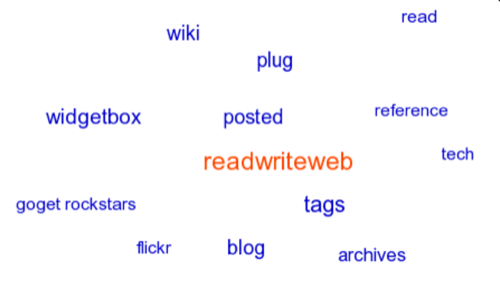Written by Emre Sokullu, with contributions by Charles Knight
Quintura is a clustering search engine, one of the Top 100 Alternative Search Engines chosen by Charles Knight. Quintura, like many other alt search engines, is focusing on user interface (UI) innovations – see our previous categorization of search engines here. The company recently closed an undisclosed amount of funding from Skype’s investors, Europe’s leading early-stage VC company Mangrove Capital Partners.

Many believe that it’s nearly impossible to convince users to switch search engines due to user interface innovations only. However I spoke to Quintura CEO Yakov Sadchikov and he told me that one should start with user interface innovation, followed by providing users with more relevant search results on the first page. So let’s open up this topic for discussion here on ReadWriteWeb.
Quintura – Clustering is its main feature
First of all, give Quintura a try. It offers visual clustering of keywords that you enter (for plain clustering, check out Clusty and Ask). Quintura is not the first search engine that clusters search results, but it is the first to provide an interactive tag cloud for deep navigation within the clusters. Yakov explained that Quintura is more of a discovery engine, good for browsing the Web and finding “hidden” information.

The usefulness of this feature is arguable, however. I think search clustering is good only in some rare cases, when you have absolutely no idea about the topic you are looking up. It does add some fancy look and feel to the search experience – something that Charles would no doubt like 🙂 – but at the price of being slightly slower compared to Google. As a result, I think the disadvantages outweigh the advantages that clustering brings.
Also check out other reviews of the “new” Quintura – Rob Garner’s Test-driving Quintura Visual Search Navigation on MediaPost and Phil Bradley’s article Quintura Relaunches with New Interface on Search Engine Land.
Quintura Kids
Now let’s look at Quintura Kids, which (as the name indicates) is a junior version of Quintura’s search engine. It is based on Quintura’s own index and therefore provides search speed comparable to the traditional search engines. Yakov told me that the feedback that Quintura has received from teachers and parents is that they are able to find kid-related content much faster, using Quintura Kids preset tag cloud and the icons on the site.

Yakov told me they are planning to add a “Search In Site” business as well – and that clustered sitemaps could come in handy in that field. I agree, because in that case Quintura’s clustering could create automatically generated sitemaps. Also as Quintura goes vertical, the UI demands will change and their visual clustering feature will come into its own.
In terms of revenue opportunities, in Michael Arrington’s article in Techcrunch – Quintura Visual Search Engine Relaunches – one commenter pointed out that the parent company of Clusty (Vivisimo) licenses its product to enterprise-level customers, providing dual revenue streams. The commenter also noted that search engine Snap is getting its search boxes on other websites. This dual revenue strategy, showcasing your technology via your search engine and then seeking out ways to market it on other sites, may be a sign of the times for the smaller alt search engines – that may not be able to survive on ad revenues alone.
Will UI innovations really be competitive with Google?
Like Quintura, Snap relies heavily on UI innovations. The problem with relying on UI innovation is that the barrier to entry is too low. The big players Google (SearchMash) and Microsoft (Live) are actively experimenting with UI innovations.
However I think UI innovations will be very suitable for vertical search engines. For example flight search engine Kayak and job search engines like SimplyHired and Indeed can deliver UIs that take into account the unique requirements of their topic focus. Quintura Kids and Quintura’s upcoming ‘Search In Site’ feature can also succeed by delivering UIs for niche audiences. However I don’t think that up and comers like Quintura Web Search can easily convince us to change our general search attitudes. It’ll take more than UI innovations to compete with Google.
Charles Knight Comments…
Ed: Charles Knight, ReadWriteWeb author of The Top 100 Alternative Search Engines, had a lot of input into this article and so he gets the final word on whether UI innovations will be competitive with Google…
Charles: there seems to be three camps into which most of the Top 100 search engines fall. Some of the alts have invented (and patented) marvelous new technologies, and seek exposure hoping to attract a cash laden buyer – thereby recouping all of the VC dollars (and maybe a few more…). Others are “not for sale,” and seek primarily to excel within their chosen niche, perhaps as the best mobile shopping search engine (e.g. Slifter), or the best video search site (e.g. PureVideo), thereby allowing them to attract a healthy revenue stream from advertisers. Quintura, by it’s own admission, is taking the high road; the third path. Yakov sees competition with “the Big Four” as not only possible, but achievable. He feels that with his UI and his own web index, his brand of vertical or user community-oriented search can take them head on.
Having evaluated literally hundreds and hundreds of alts (of which only 148 have been featured on R/WW so far!), I have become a ‘true believer’ in the fourth alternative. Contrary to what you may surmise, I do not believe that any of the Top 100 alternative search engines is a ‘Google Killer;’ but: they all are!
I leave you with this thought: Aesop (of “Aesop’s fables”) wrote a story about the four oxen and the lion (translated here by G.F. Townsend):
A Lion used to prowl about a field in which four oxen used to dwell. Many a time he tried to attack them; but whenever he came near they turned their tails to one another, so that whichever way he approached them he was met by the horns of one of them. At last, however, they fell a-quarrelling among themselves, and each went off to pasture alone in a separate corner of the field. Then the Lion attacked them one by one and soon made an end of all four. “United we stand, divided we fall.”
Are you listening, alts?










